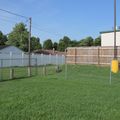Dogs love to play, and they need to exercise. The bigger they are, the more room they need to run and play. People know this, but they don’t always have a nice fenced yard. Sometimes they let them off the leash. Of course, I’ve seen so many pets who have been injured or killed by automobiles, that I really hate that. Fencing can be expensive, or unattractive, or sometimes just ineffective. I’ve always liked the concept of the “invisible fence”, or underground dog fence, but hesitated to recommend it until now. That’s because you absolutely MUST train the dog to understand it for it to be safe and effective. I’ve just recently found a company that doesn’t just sell you equipment, but also provides you with a complete training program. I rarely endorse a commercial product, but Dog Fence DYI looks like a great outfit to me.
 People have different feelings about confining their dogs. “I don’t want my dog to stay in a cage.”
People have different feelings about confining their dogs. “I don’t want my dog to stay in a cage.”
Some folks put them outside, but keep them tied up. You have a more interesting view, but staying tied up all the time makes a lot of dogs wacky. It messes with their heads. They are not happy.
 “Man, I’d love to have a big fenced yard like that, but I can’t afford it.” (That’s the exercise yard behind Kennett Veterinary Clinic). Other people look at a five-foot chain-link fence like that, and think “That would be great for my dog, but it looks way too industrial. That would NOT go with my house.” I have a fence like that at home, too, and my dad used to call it “the compound”.
“Man, I’d love to have a big fenced yard like that, but I can’t afford it.” (That’s the exercise yard behind Kennett Veterinary Clinic). Other people look at a five-foot chain-link fence like that, and think “That would be great for my dog, but it looks way too industrial. That would NOT go with my house.” I have a fence like that at home, too, and my dad used to call it “the compound”.
 Here we have a neat shot of two types of fancy privacy fence right along with the chain-link. They look great, but the cost sure goes up, and you have to enjoy that feeling of living inside a fort. And of course, sometimes dogs dig right out of the prettiest fence in town (or even climb over it). That is pretty unlikely to happen with the “invisible” type of fencing system, provided that your dog understands what is going on. Hey, I guess you need to understand what’s going on, too.
Here we have a neat shot of two types of fancy privacy fence right along with the chain-link. They look great, but the cost sure goes up, and you have to enjoy that feeling of living inside a fort. And of course, sometimes dogs dig right out of the prettiest fence in town (or even climb over it). That is pretty unlikely to happen with the “invisible” type of fencing system, provided that your dog understands what is going on. Hey, I guess you need to understand what’s going on, too.
Here is how this type of fencing system works. It is a type of electric dog fence. You have a radio transmission unit that you install in a sheltered area (garage, porch, utility room, etc.). From this, a wire extends and you bury this underground around the entire perimeter you want to fence. This is a transmitting antenna for the radio signal. Your dog wears a collar that is the radio receiver, tuned to this precise frequency so other things cannot set it off. When he approaches the buried wire, the collar receives the signal and beeps. If he gets even closer, he gets a static electricity type of shock, as you would in the winter when you touch the doorknob. Stay away from the wire, no beep. Keep on going after you hear the beep, and the dog gets a mild, but unpleasant surprise.
The problem I have had in the past is that my clients haven’t really understood how to train the dog to understand his limits. If you just bury the wire, turn on the juice and buckle on the collar, it’s not going to work. The dog will blast off chasing a squirrel, and get shocked on the way out, but he’s so excited that he keeps on going. Later on, he’s calmed down and it’s time to come home, but he keeps getting shocked when he tries to come home. This is a mess.
These extensive electric dog fence training resources that Dog Fence DIY has put together make it much easier to be successful with this type of fencing.
I haven’t done any comparison shopping as to the pricing or reliability of equipment, but here are some underground fence reviews that DIY has put together on their website. Their commitment to training for dog and owner makes me pretty confident that the equipment will be pretty good, too.
One cool thing about this type of fencing system is that no matter how big your yard is, the cost of a few more yards of antenna wire is about nothing. This means that the cost of putting in this type of fence doesn’t get much bigger with a really big yard. You could fence five acres for little more expense than the average backyard. Here is an overview of the cost of an underground dog fence.
If you have a hedge or ornamental fencing, you can keep it. It just helps to reinforce where the dog’s boundaries are. You get to keep your lovely view and your fence doesn’t detract from the appearance of your home.
You can go around irregular boundaries with ease, and also use the same system to keep your dog out of your flower beds without concealing your flowers.
As I say, I’ve always liked the idea of this type of fencing, but without good training, it was usually a bust. The reason I’m now pumped up about it is this company’s commitment to providing that training, complete with a hotline for any questions or problems you have. It’s not going to be for everyone, and here are some guidelines to help you decide if a wired or wireless dog fence is right for you and your dog.
Whenever I see a new patient, I try to find out about its lifestyle. “How long have you had him? Are there other pets in the home? What does he eat? Is he inside or outside?" If the patient is a dog, then I would also ask, ”When he’s outside, is the yard fenced, or does someone stay with him?” I usually add that “I’m not selling fences, I just need to know how he lives.” That’s true, but a fenced yard is a big protector of your dog’s health.
I’m all about protecting your dog’s health, and seeing these extensive training resources makes me enthusiastic about promoting this type of fencing system.


Like you, I’m all for whatever is best for your pet (or any animal for that matter). And when I first startedstarted reading this article, I was getting kind of excited! (It’s time to replace the old raggedy fence that came with my house). But something just occurred to me, with training it sounds like a wonderful, economical and responsible way to contain your dog. But my concern is, what about the dogs whose parents aren’t as responsible or the dogs who are Houdini-like and escape? What stops them from coming into your yard where a possible fight could ensue? Or an aggressive stray? That would worry me. Another thought I had is: I wonder if they make an invisible fence for cats? To me, that would be a great option! Cats are less likely to see another cat and run up to it and start problems. Plus, it will keep the cat in your yard and safe from being hit by a car. I had a kitty that I chose to have as an indoor cat, but she was miserable and just wanted to get outside. Eventually, I relented and started letting her go out…. She was hit by a car while being chased across the street by another cat and died. It never occurred to me that there might be some way to keep your cat in your yard. Any ideas on that?
Hi,
I just purchased PetSafe PIF 300 wireless dog fence reading the article here http://www.pethov.com/best-invisible-dog-fence-reviews/. I am currently training my dog. You said, “without good training, it was usually a bust”
I got a training manual inside the box. I am mostly following that. Do I need to do anything extra? Or should I hire are a trainer?
And how long it would take to train my dog properly?
Thanks
Hello, Daniel,
I would very much recommend looking at the company’s videos. They give more detail. I don’t think you need to hire a trainer.
The point is that the dog has to understand what’s going on. You can’t just bury the wire and buckle on the collar.
How long would it take to train a dog to get used to this electric dog fence? I suppose it depends a lot on the dog.
I think that’s true. Some dogs are smart, some are too smart for their own good, and some are slow learners.
I’ve never used one, myself. I hot-wired the bottom of our chain-link perimeter fence (difficult to insulate and keep from grounding out, plus could shock kids, but I didn’t have any at the time).